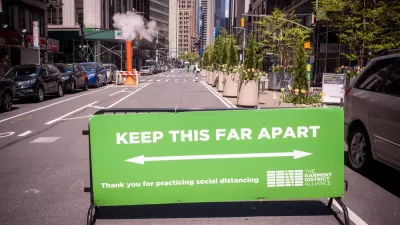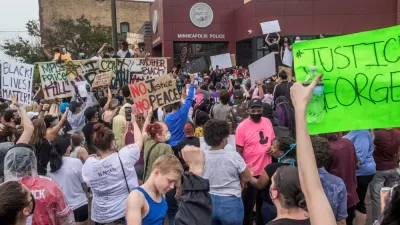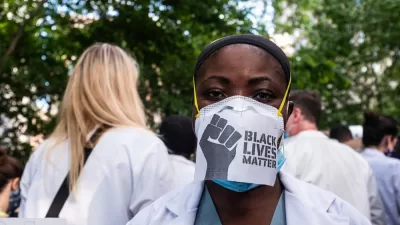A leading advocate for a new, equity centering approach explains how plans to redesign streets for the needs of the coronavirus pandemic left behind racial justice as a secondary concern.

Dr. Destiny Thomas writes for CityLab to explain and illustrate the advocacy for a new kind of attention to be paid to social justice and public safety for Black Americans as planners and advocates press for planning innovations in the public realm.
It's not enough to equate traffic safety and bike and pedestrian and bike infrastructure with social justice, according to Thomas, given the realities of racism in the United States.
The quick deployment of slow streets, al fresco streets, and open streets in the first months of the coronavirus was already raising alarms for Thomas, along with others, before the killings of Ahmaud Arbery and George Floyd shifted public awareness from the pandemic to racial justice:
But to me, as a Black planner and community organizer, the lack of process and participatory decision-making behind these projects was an absolute nightmare. Pop-up bike lanes, guerrilla-urbanist playgrounds, and tactical walkways have been notorious for being politically crude for as long as I’ve been in the field: By design, their “quick-build” nature overrides the public feedback that is necessary for deep community support. Without that genuine engagement, I feared that pandemic-induced pedestrian street redesigns would deepen inequity and mistrust in communities that have been disenfranchised and underserved for generations.
Here, Thomas lays out the fundamental issues that undercut the progressive values intended to manifest in projects that reclaim public space from cars:
The announcement of open streets from Oakland to Minneapolis to New York City left me wondering how advocates for them would respond to data showing Black people make up 87% of those who are being criminalized in the name of “social distancing” in Brooklyn, where Covid-19 is still largely uncontained. Similarly, I thought about the ways Black, Brown, Indigenous People, people of color, as well as trans people, are regularly policed, harassed, and killed in the built environment. That violence could be heightened in spaces where the main understanding of personal safety centers on vehicle traffic, as opposed to valid concerns about racism, transphobia and xenophobia and the territorial entitlement to space that often shows up in newly gentrified communities.
The article is recommended as a clear, authoritative expression of the ideas and causes put forward by the Black Lives Matter movement where it intersects with ostensibly progressive trends in urban planning.
FULL STORY: ‘Safe Streets’ Are Not Safe for Black Lives

Alabama: Trump Terminates Settlements for Black Communities Harmed By Raw Sewage
Trump deemed the landmark civil rights agreement “illegal DEI and environmental justice policy.”

Study: Maui’s Plan to Convert Vacation Rentals to Long-Term Housing Could Cause Nearly $1 Billion Economic Loss
The plan would reduce visitor accommodation by 25% resulting in 1,900 jobs lost.

Planetizen Federal Action Tracker
A weekly monitor of how Trump’s orders and actions are impacting planners and planning in America.

Wind Energy on the Rise Despite Federal Policy Reversal
The Trump administration is revoking federal support for renewable energy, but demand for new projects continues unabated.

Passengers Flock to Caltrain After Electrification
The new electric trains are running faster and more reliably, leading to strong ridership growth on the Bay Area rail system.

Texas Churches Rally Behind ‘Yes in God’s Back Yard’ Legislation
Religious leaders want the state to reduce zoning regulations to streamline leasing church-owned land to housing developers.
Urban Design for Planners 1: Software Tools
This six-course series explores essential urban design concepts using open source software and equips planners with the tools they need to participate fully in the urban design process.
Planning for Universal Design
Learn the tools for implementing Universal Design in planning regulations.
Caltrans
Smith Gee Studio
Institute for Housing and Urban Development Studies (IHS)
City of Grandview
Harvard GSD Executive Education
Toledo-Lucas County Plan Commissions
Salt Lake City
NYU Wagner Graduate School of Public Service





























